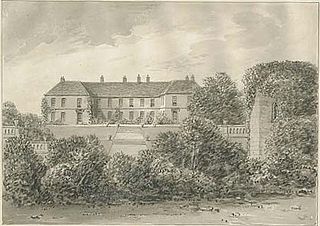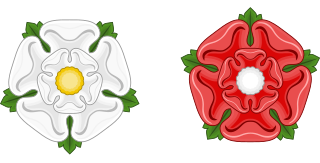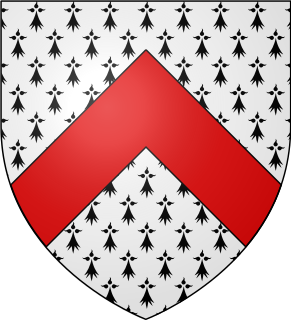Year 1459 (MCDLIX) was a common year starting on Monday of the Julian calendar.

Henry Beaufort, 3rd Duke of Somerset was an important Lancastrian military commander during the English Wars of the Roses. He is sometimes numbered the 2nd Duke of Somerset, because the title was re-created for his father after his uncle died. He also held the subsidiary titles of 5th Earl of Somerset, 2nd Marquess of Dorset and 2nd Earl of Dorset.

Eccleshall Castle is located in Eccleshall, Staffordshire, England. It was originally built in the 13th century. It is a Scheduled Ancient Monument and a Grade II* listed building.

The Battle of Blore Heath was a battle in the English Wars of the Roses. It was fought on 23 September 1459, at Blore Heath in Staffordshire. Blore Heath is a sparsely populated area of farmland, two miles east of the town of Market Drayton in Shropshire, and close to the village of Loggerheads, Staffordshire.

Market Drayton is a market town and electoral ward in the north of Shropshire, England, close to the Cheshire and Staffordshire borders. It is on the River Tern, and was formerly known as "Drayton in Hales" and earlier simply as "Drayton".

The Rout of Ludford Bridge was a largely bloodless confrontation fought in the early years of the Wars of the Roses. It took place on 12 October 1459, and resulted in a setback for the Yorkists. Although this seemed to be a triumph for the rival Lancastrians at the time, they had thrown away their advantage within six months.

John Sutton VI, 1st Baron Dudley, KG, was an English nobleman, a diplomat, and councillor of King Henry VI. He fought in several battles during the Hundred Years War and the Wars of the Roses, as well as acting as Lord Lieutenant of Ireland from 1428 to 1430.

James Tuchet, 5th Baron Audley, 2nd Baron Tuchet of Heleigh Castle was an English peer.

The battle of Hopton Heath was a battle of the First English Civil War, fought on Sunday 19 March 1643 between Parliamentarian forces led by Sir John Gell and Sir William Brereton and a Royalist force under Spencer Compton, 2nd Earl of Northampton.

Hawkstone Park is a historic landscape park with pleasure grounds and gardens formerly belonging to Hawkstone Hall, just north east of the small village of Weston-under-Redcastle, near to Wem, in Shropshire, England. It is one mile (1.6 km) east of the A49 road. The park is known for its follies.
Sir Thomas Dutton was a medieval English knight. He was the son of Sir John Dutton and Margaret Savage.

Sutton upon Tern is a civil parish in Shropshire, England. Expanded in 1914 after the abolition of the parish Drayton in Hales, Its name in Old English means 'South farm/settlement' on the River Tern. It is situated south of Market Drayton, on the River Tern.

Sir Thomas Stanley, 1st Baron Stanley, titular King of Mann, KG, of Lathom and Knowsley, Lancashire, was a Privy Councillor, Comptroller of the Royal Household, Lieutenant-Governor of Ireland (1431–36), Chief Steward of the Duchy of Lancaster, Knight of the Shire for Lancashire, Constable & Justice of Chester, Chamberlain of North Wales, Lord Chamberlain (1455), and from 15 January 1456 was summoned by Writ to Parliament as Lord Stanley.
Events from the 1450s in England.
Events from the year 1459 in England.
Henry Grey, 2nd Earl of Tankerville, 7th Lord of Powys was an English peer. He was the son of John Grey, 1st Earl of Tankerville and his wife Joan Charleton, co-heiress and 6th Lady of Powys.
Sir Roger Kynaston of Myddle and Hordley was a Knight of the Realm and English nobleman. He was a member of the Kynaston family, of North Shropshire and the Welsh Marches.
Battlefields are the final resting place for thousands of unknown soldiers, both nobles and commoners, whose lives were sacrificed in the making of the history of their country. These historic assets are an intrinsic part of a nation’s identity and consciousness. They inspire strong emotions and live on in stories, poetry and music. However, the history relating to them is often hard to unravel, as there is often little to see above ground and the historical record is usually written by the victors. The UK has many historic battlefield sites, some of which have legal protection through heritage protection legislation whilst others are protected through landscape legislation. More recently, some archaeologists prefer the term "site of conflict" to "battlefield", because of the difficulty in defining the geographical extent of a site.

Millom Castle is an ancient building at Millom in Cumbria. It is a Grade I listed building and scheduled ancient monument.
Sir Thomas Neville was the second son of Richard Neville, 5th Earl of Salisbury, a major nobleman and magnate in the north of England during the fifteenth-century Wars of the Roses, and a younger brother to the more famous Richard Neville, Earl of Warwick, the 'Kingmaker'. Thomas worked closely with them both in administering the region for the Crown, and became a significant player in the turbulent regional politics of northern England in the early 1450s, especially in the Neville family's growing local rivalry with the House of Percy. His wedding in August 1453 is said to have marked the beginning of the armed feud between both houses, in which Thomas and his brother John led a series of raids, ambushes and skirmishes across Yorkshire against the Percy family. Historians describe the feud as setting the stage for the Wars of the Roses, the dynastic struggle between the houses of Lancaster and York for the English throne, and Thomas played a large role in the Neville family's alliance with his uncle, Richard, Duke of York.












